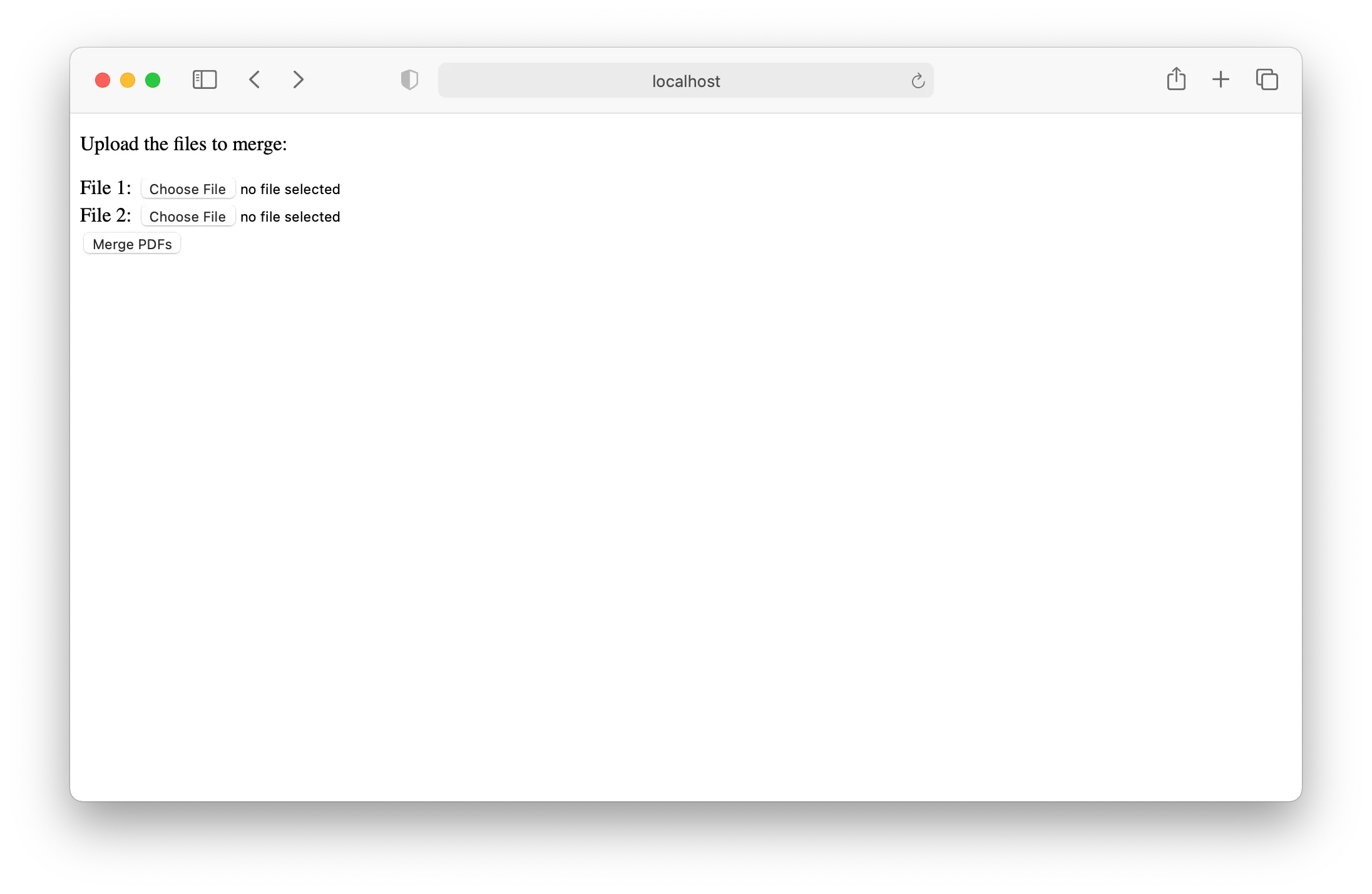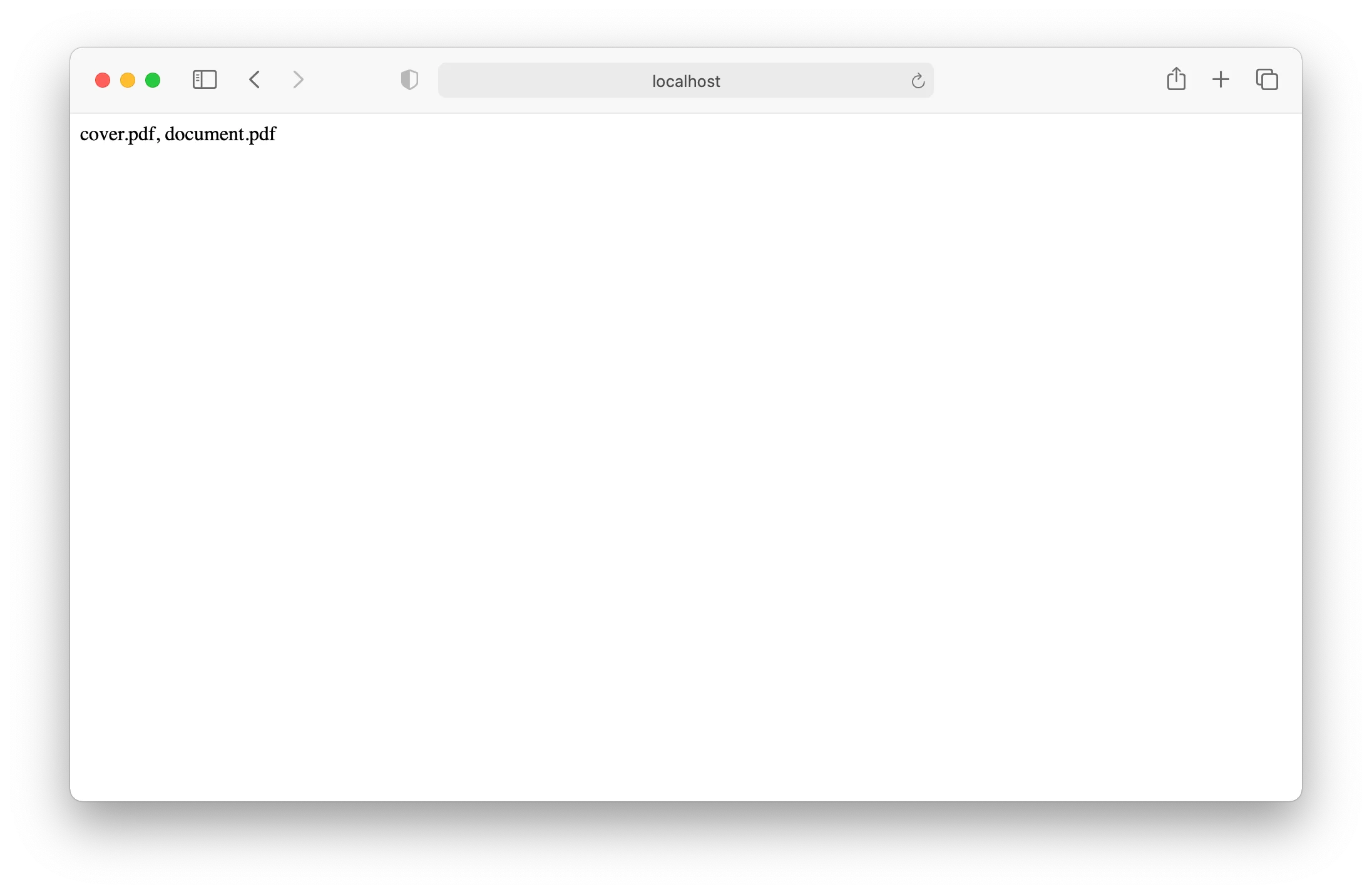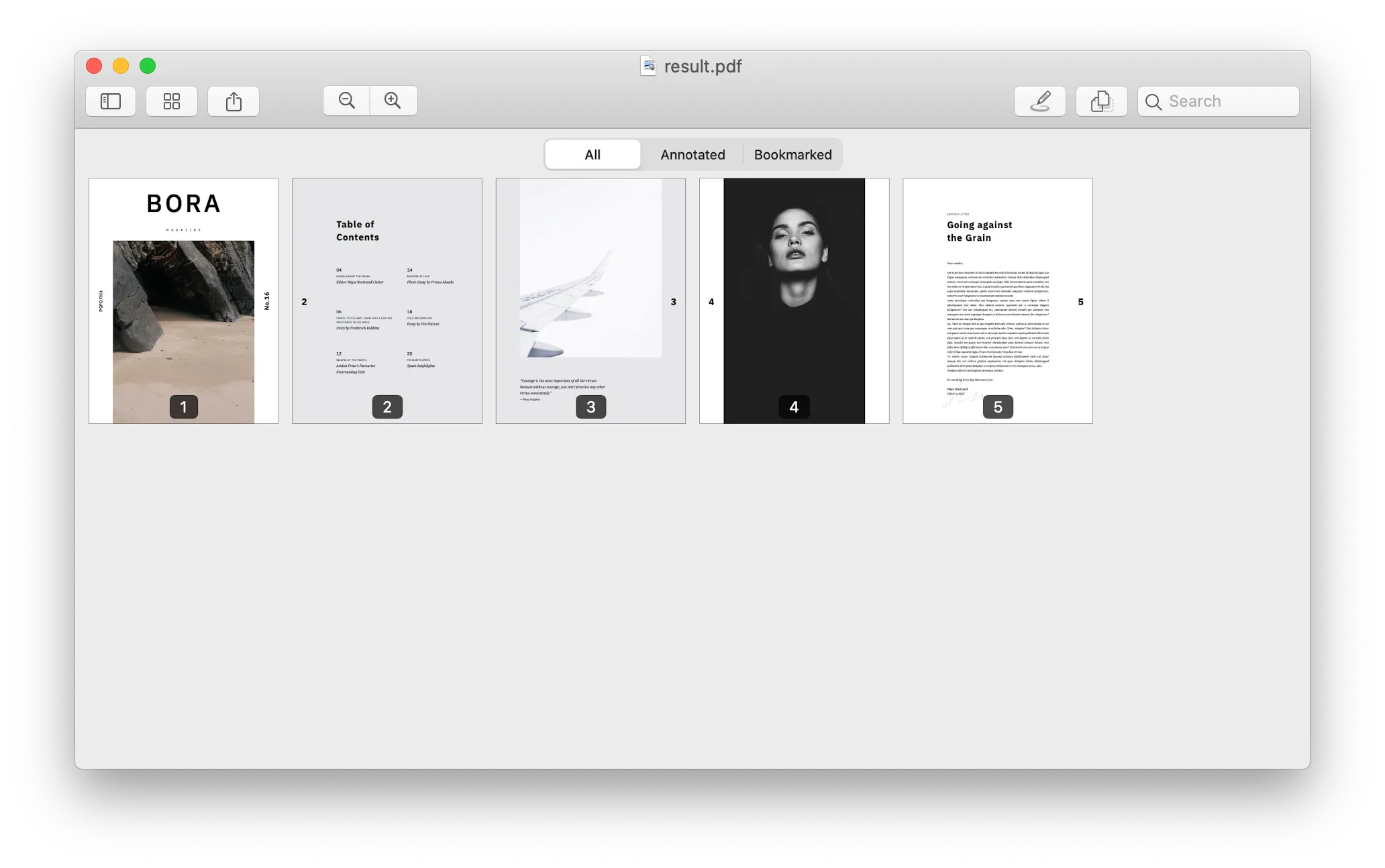Process documents with Document Engine and PHP
This guide walks you through the steps necessary to start Document Engine. It also shows you how to use it to process documents. By the end, you’ll be able to merge two PDF documents into one using Document Engine’s HTTP API from PHP.
Requirements
Document Engine is compatible with a range of platforms. Below is the list of supported operating systems.
- macOS:
- Ventura
- Monterey
- Mojave
- Catalina
- Big Sur
- Linux:
- Ubuntu, Fedora, Debian, and CentOS
- Ubuntu and Debian derivatives (such as Kubuntu, Xubuntu) are also supported
Processor requirements:
- 64-bit Intel (x86_64) processors
- ARM (AArch64) processors
Minimum system requirements:
- At least 4GB of RAM, regardless of the operating system
Installing Docker
Document Engine is distributed as a Docker container. To run it on your computer, you need to install a Docker runtime distribution for your operating system.
Install and start Docker Desktop for Mac. For detailed instructions, refer to the Docker website(opens in a new tab).
Install and start Docker Desktop for Windows. For detailed instructions, refer to the Docker website(opens in a new tab).
Document Engine runs as a Linux container. If you’re using Docker Desktop for Windows, ensure it’s configured to work with Linux containers. For detailed steps, refer to the How do I switch between Windows and Linux containers? section in the Docker documentation(opens in a new tab). Users with Docker already set up might need to switch from Windows containers to Linux containers for compatibility.
Install and start Docker Engine. For detailed instructions on how to install Docker Engine for your Linux distribution, refer to the Docker website(opens in a new tab).
Once you finish installing Docker Engine, follow the instructions(opens in a new tab) to install Docker Compose.
Starting Document Engine
To start Document Engine, follow the steps below.
Open your terminal emulator.
Use the terminal emulator integrated with your code editor or IDE. Alternatively, you can use
Terminal.appor iTerm2(opens in a new tab).Use your code editor’s integrated terminal or PowerShell(opens in a new tab).
Use the terminal emulator integrated with your code editor or IDE, or the one bundled with your desktop environment.
Run the following command to start the Document Engine container:
docker run --rm -t -p 5000:5000 -e API_AUTH_TOKEN=secret pspdfkit/document-engine:1.13.0This command may take some time to complete depending on your internet connection speed, as it needs to pull the Docker image. You’ll know that Document Engine is successfully running when you see a message similar to the following in your terminal:
[info] 2024-02-05 18:56:45.286 Running Document Engine version 1.13.0Document Engine is now up and running!
Installing PHP
The interaction with Document Engine happens through its HTTP API — You send documents and commands in the request and receive the resulting file in the response. To do this, you’ll invoke the API from the PHP script. But first, you need to install PHP for your operating system:
The most direct way to install PHP on macOS is using Homebrew. Follow the instructions on the Homebrew website(opens in a new tab) to install it. Then, to install PHP, run:
brew install php@7.4 && brew link php@7.4Verify the installation by running the following command in the terminal:
php --versionThe output should start with PHP 7.4 — you can ignore the rest of the message.
If the output doesn’t match the above, try restarting your terminal app by typing
exitand opening it again.
- Download the PHP ZIP archive from the PHP website(opens in a new tab) (pick the x86 Thread Safe build of the 7.4 release).
- Create a folder anywhere on your C: drive.
- Extract the ZIP archive into the folder you just created.
- Open the terminal and switch to that folder:
cd C:\path\to\directoryNow run the .\php.exe --version command. The output should start with PHP 7.4 — you can ignore the rest of the message.
To proceed, you’ll also need to create a PHP configuration file to enable a specific extension. So in the same directory, create a php.ini file with the following content:
[PHP]extension=curlSave the file, as you’ll need it shortly.
You can install PHP using your distribution’s package manager:
apt-get update && apt-get install -y phpdnf install -y phpNow run the php --version command. The output should start with PHP 7.4 — you can ignore the rest of the message.
Handling file uploads
In this example project, the PDF files you’ll merge will be uploaded through a simple webpage via a standard HTML form. Create a file called index.php with the following content:
<!DOCTYPE html><html><head> <title>Merge PDFs with Document Engine</title></head><body> <p>Upload the files to merge:</p> <form enctype="multipart/form-data" action="merge.php" method="post"> <div>File 1: <input name="file1" type="file" accept="application/pdf"></div> <div>File 2: <input name="file2" type="file" accept="application/pdf"></div> <input type="submit" value= "Merge PDFs"> </form></body></html>Now open the terminal and type the following command in the same directory where you created the index.php file:
php -S localhost:8000.\php.exe -c php.ini -S localhost:8000php -S localhost:8000Go to http://localhost:8000 in the browser. You should see a webpage similar to this:

When you choose files and click the Merge PDFs button, you’ll receive an error. This is because you haven’t yet written any code to handle the form submission.
Create a merge.php file in the same directory and add the following content to it:
<?php$file1 = $_FILES['file1'];$file2 = $_FILES['file2'];
echo $file1['name'], ", ", $file2['name'];?>Now when you go back to http://localhost:8000, choose the files, and submit the form, you should see the names of the files you picked printed on the screen:

Merging PDFs
You can now use Document Engine’s API to merge the files uploaded from the browser. Replace the contents of the merge.php file with:
<?php$file1 = $_FILES["file1"];$file2 = $_FILES["file2"];
$headers = [ "Content-Type" => "multipart/form-data", "Authorization" => "Token token=secret"];$postFields = [];$postFields["document1"] = curl_file_create( $file1["tmp_name"], $file1["type"], $file1["name"]);
$postFields["document2"] = curl_file_create( $file2["tmp_name"], $file2["type"], $file2["name"]);
$postFields["instructions"] = json_encode([ "parts" => [ [ "file" => "document1" ], [ "file" => "document2" ] ],]);
$request = curl_init();curl_setopt($request, CURLOPT_URL, "http://localhost:5000/api/build");curl_setopt($request, CURLOPT_HTTPHEADER, $headers);curl_setopt($request, CURLOPT_POST, true);curl_setopt($request, CURLOPT_POSTFIELDS, $postFields);curl_setopt($request, CURLOPT_RETURNTRANSFER, true);$response = curl_exec($request);
$status = curl_getinfo($request, CURLINFO_RESPONSE_CODE);$file_size = curl_getinfo($request, CURLINFO_CONTENT_LENGTH_DOWNLOAD);curl_close($request);
if ($status != 200) { echo "Request to Document Engine failed with status code " . $status . ': "' . $response . '".';} else { header("Content-type: application/pdf"); header('Content-Disposition: attachment; filename="result.pdf"'); header("Content-Transfer-Encoding: binary"); header("Content-Length: " . $file_size); header("Accept-Ranges: bytes"); echo $response;}Most of this code, up until the curl_exec function, constructs a request that’s sent to Document Engine. It includes two files — document1 and document2 — and a list of instructions for Document Engine. By default, Document Engine’s output for the /api/build endpoint is the result of merging all documents or parts of the instructions. To learn more about the /api/build instructions, go to Document Engine’s API Reference.
The rest of the code deals with error handling, and if everything goes well, it returns the resulting file back to the browser.
You can check how it works in practice yourself! Go to http://localhost:8000, pick any two PDFs on your disk (or use file1.pdf and file2.pdf if you don’t have any), and click Merge PDFs again. Depending on your browser, it will either automatically download the file for you or ask you for permission to download. In any case, look for the result.pdf file in the downloads folder on your computer. Open that file in any PDF viewer application. If you used the two files from the links above, you should see a five-page PDF document like what’s shown below.

That’s it! Now you know how to use Document Engine’s API to perform operations on documents with PHP. To learn more about the various operations you can perform on documents with Document Engine, visit Document Engine’s API Reference